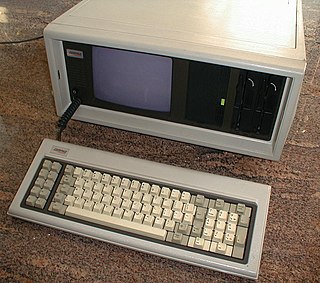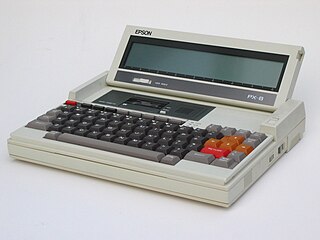Related Research Articles
The editor war is the rivalry between users of the Emacs and vi text editors. The rivalry has become an enduring part of hacker culture and the free software community.
Emacs Lisp is a dialect of the Lisp programming language used as a scripting language by Emacs. It is used for implementing most of the editing functionality built into Emacs, the remainder being written in C, as is the Lisp interpreter. Emacs Lisp is also termed Elisp, although there are also older, unrelated Lisp dialects with that name.

WordStar is a word processor application for microcomputers. It was published by MicroPro International and originally written for the CP/M-80 operating system, with later editions added for MS-DOS and other 16-bit PC OSes. Rob Barnaby was the sole author of the early versions of the program.

CP/M, originally standing for Control Program/Monitor and later Control Program for Microcomputers, is a mass-market operating system created in 1974 for Intel 8080/85-based microcomputers by Gary Kildall of Digital Research, Inc. CP/M is a disk operating system and its purpose is to organize files on a magnetic storage medium, and to load and run programs stored on a disk. Initially confined to single-tasking on 8-bit processors and no more than 64 kilobytes of memory, later versions of CP/M added multi-user variations and were migrated to 16-bit processors.
Kaypro Corporation was an American home and personal computer manufacturer based in Solana Beach in the 1980s. The company was founded by Non-Linear Systems (NLS) to compete with the popular Osborne 1 portable microcomputer. Kaypro produced a line of rugged, "luggable" CP/M-based computers sold with an extensive software bundle which supplanted its competitors and quickly became one of the top-selling personal computer lines of the early 1980s.

The Osborne Computer Corporation (OCC) was an American computer company and pioneering maker of portable computers. It was located in the Silicon Valley of the southern San Francisco Bay Area in California. Adam Osborne, the founder of the company, developed, with design work from Lee Felsenstein, the world's first mass-produced portable computer in 1981.

The Osborne 1 is the first commercially successful portable computer, released on April 3, 1981 by Osborne Computer Corporation. It weighs 24.5 lb (11.1 kg), cost US$1,795, and runs the CP/M 2.2 operating system. It is powered from a wall socket, as it has no on-board battery, but it is still classed as a portable device since it can be hand-carried when the keyboard is closed.

A portable computer is a computer designed to be easily moved from one place to another, as opposed to those designed to remain stationary at a single location such as desktops and workstations. These computers usually include a display and keyboard that are directly connected to the main case, all sharing a single power plug together, much like later desktop computers called all-in-ones (AIO) that integrate the system's internal components into the same case as the display. In modern usage, a portable computer usually refers to a very light and compact personal computer such as a laptop, miniature or pocket-sized computer, while touchscreen-based handheld ("palmtop") devices such as tablet, phablet and smartphone are called mobile devices instead.

Mark of the Unicorn (MOTU) is a music-related computer software and hardware supplier. It is based in Cambridge, Massachusetts and has created music software since 1984. In the mid-1980s, Mark of the Unicorn sold productivity software and several games for the Macintosh, Atari ST, and Amiga.

Conkeror is a Mozilla-based web browser designed to be navigated primarily by a computer keyboard. Its design is mainly patterned after the text editor GNU Emacs, with some influence from other programs, including vi.
This article provides basic comparisons for notable text editors. More feature details for text editors are available from the Category of text editor features and from the individual products' articles. This article may not be up-to-date or necessarily all-inclusive.

The Epson QX-10 is a microcomputer running CP/M or TPM-III which was introduced in 1983. It was based on a Zilog Z80 microprocessor, running at 4 MHz, provided up to 256 KB of RAM organized in four switchable banks, and included a separate graphics processor chip (µPD7220) manufactured by NEC to provide advanced graphics capabilities. In the USA and Canada, two versions were launched; a basic CP/M configuration with 64 KB RAM and the HASCI configuration with 256 KB RAM and the special HASCI keyboard to be used with the bundled application suite, called Valdocs. TPM-III was used for Valdocs and some copy protected programs like Logo Professor. The European and Japanese versions were CP/M configurations with 256 KB RAM and a graphical BASIC interpreter.
Sprint is a text-based word processor for MS-DOS, first published by Borland in 1987.
BDS C is a compiler for a sizeable subset of the C programming language, that ran on and generated code for the Intel 8080 and Zilog Z80 processors. It was the first C compiler for CP/M. It was written by Leor Zolman and first released in 1979 when he was 20 years old. "BDS" stands for "Brain Damage Software."

The Epson PX-8 a.k.a. Geneva was a small laptop computer made by the Epson Corporation in the mid-1980s.
Scribe is a markup language and word processing system that pioneered the use of descriptive markup. Scribe was revolutionary when it was proposed, because it involved for the first time a clean separation of presentation and content.
GNU Emacs is a free software text editor. It was created by GNU Project founder Richard Stallman, based on the Emacs editor developed for Unix operating systems. GNU Emacs has been a central component of the GNU project and a flagship project of the free software movement. Its tag line is "the extensible self-documenting text editor."
Emacs, originally named EMACS, is a family of text editors that are characterized by their extensibility. The manual for the most widely used variant, GNU Emacs, describes it as "the extensible, customizable, self-documenting, real-time display editor". Development of the first Emacs began in the mid-1970s, and work on GNU Emacs, directly descended from the original, is ongoing; its latest version is 29.2, released January 2024.
Perfect Writer is a word processor computer program published by Perfect Software for CP/M. In 1984, Thorn EMI Computer Software acquired an exclusive marketing and distribution licence for Perfect Software's products, and the program was rewritten and released as Perfect II for IBM PC compatible computers. Written in C and famous for its stability, it was an enhanced version of MINCE, which itself was a version of Emacs for microcomputer platforms. Emacs itself was too heavyweight to fit within the 64 KB RAM limit of most microcomputers. Like MINCE, it included a floppy disk based virtual memory system.
References
- ↑ Waite, Mitchell; Lafore, Robert; Volpe, Jerry (1985). The Official Book for the Commodore 128. Howard W. Sams & Co. p. 108. ISBN 0-672-22456-9. LCCN 85-50977 . Retrieved 2016-06-24.
Some excellent applications programs for CP/M were written in BDS-C, including the Mince text editor (from Mark of the Unicorn) and the PeachText word processor (from PeachTree)
- ↑ "System Review The Kaypro II". Archived from the original on May 27, 2014. Retrieved May 24, 2014.
- ↑ "Epson QX-10". Computing History. Retrieved 2016-06-24.
- 1 2 "Mark of the Unicorn Amethyst". BYTE (Ad). Vol. 6, no. 6. June 1981. p. 179. Retrieved 2016-06-24.
- ↑ "ftp.nisc.sri.com: netinfo/interest-groups" (TXT). 21 September 1990. Retrieved 2016-06-24– via TEXTFILES.COM.
This list is intended for people who use Amethyst, a software package of CP/M-80 programs: MINCE (an ersatz EMACS) and SCRIBBLE (an ersatz SCRIBE)
- ↑ "The Programmer's Shop". InfoWorld (Ad). Vol. 5, no. 40. 1983-10-03. p. 34. Retrieved 2016-06-24.
